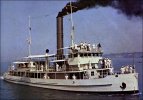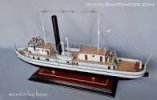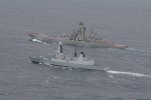Install the app
How to install the app on iOS
Follow along with the video below to see how to install our site as a web app on your home screen.
Note: This feature may not be available in some browsers.
-
Please take a moment and update your account profile. If you have an updated account profile with basic information on why you are on Air Warriors it will help other people respond to your posts. How do you update your profile you ask?
Go here:
Edit Account Details and Profile
You are using an out of date browser. It may not display this or other websites correctly.
You should upgrade or use an alternative browser.
You should upgrade or use an alternative browser.
Ship Photo of the Day
- Thread starter Randy Daytona
- Start date
Love the movie!The excellent movie “The Sand Pebbles” starring the “King of Cool” (and former Marine) Steve McQueen revolved around a gunboat on China’s rivers in the 1920’s. The replica was a diesel powered, steel hulled 150 ft ship seaworthy enough to travel from Hong Kong to Taiwan and back.
View attachment 43618
View attachment 43619
View attachment 43620
Every time I see one of these mega-ships I first wonder when it will tip over. After that, I wonder what it would look like in a submarine periscope and what a juicy target it would make.Soon to launch from a shipyard in Finland will be the 3rd Icon class cruise ship Legend of the Seas. At 1,197 feet long and a beam of 213 feet, the ship displaces just over 250,000 tons - 5 times the tonnage of the Titanic. With over 5,000 passengers, the ship has a crew of nearly 2,500. Interestingly, the ship will burn LNG.
View attachment 43610
View attachment 43611
View attachment 43612
GroundPounder
Well-Known Member
Alexander Marinesko would be able to describe the feeling.Every time I see one of these mega-ships I first wonder when it will tip over. After that, I wonder what it would look like in a submarine periscope and what a juicy target it would make.
Recently photographed at the bottom of Ironbottom Sound was IJN Teruzuki, an Akizuki class destroyer. Similar to the anti-aircraft light cruiser Atlanta, it was designed to shield carriers with 8 (4x2) dual purpose 100 mm cannons.
It was sunk on 12 December 1942 by torpedoes from American PT Boats.
Length: 450 ft, Beam: 38 ft, Displacement: 2,700 tons
52,000 SHP through 2 screws gave 33 knots.
Main armament 8 (4x2) 100 mm cannons, multiple 25 mm autocannons, 1 quadruple 24” Long Lance torpedo launcher.
The Sinking of the IJN Teruzuki from USNI:
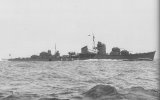

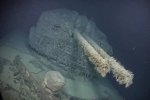
It was sunk on 12 December 1942 by torpedoes from American PT Boats.
Length: 450 ft, Beam: 38 ft, Displacement: 2,700 tons
52,000 SHP through 2 screws gave 33 knots.
Main armament 8 (4x2) 100 mm cannons, multiple 25 mm autocannons, 1 quadruple 24” Long Lance torpedo launcher.
The Sinking of the IJN Teruzuki from USNI:



One of the Presidential yachts, USS Potomac. Originally a 165 ft Icarus class Coast Guard cutter named Electra commissioned in 1934, it was transferred to the Navy in 1936. A favorite of Presidential Franklin Roosevelt, it was eventually purchased by Elvis Presley who donated it to the very worthwhile St Jude Foundation to help children with cancer. From there it eventually ended up as a museum in San Francisco where you can see it (or take a 3 hour cruise) today.

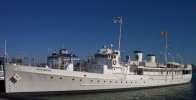


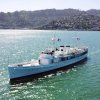

The USS Potomac … Elvis Presley’s Gift to St. Jude Hospital
Elvis Presley donated FDR’s presidential yacht, the Potomac, to St. Jude Hospital in 1964.
www.elvis-history-blog.com




The largest surface warfare ship active as of now is the Russian Kirov class heavy cruiser Peter the Great. It is currently the flagship of Russia’s Northern Fleet.
A big ship with a length of 823 ft, a beam of 95 ft and a displacement of 26,000 tons, it is capable of 31 knots.
Heavily armed with 20 “Shipwreck” anti-ship missiles, it also carries 12 S-300 missile launchers and 16 launchers for shorter range SA-9’s. Guns include 6 dual 30mm CIWS and a dual barrel automatic 130mm cannon mount.
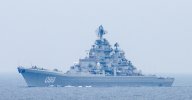
Pyotr Veliky in 2017

Pyotr Velikiy during Northern and Baltic Fleet tactical exercises in 2003

Pyotr Velikiy(background) escorted by HMS Dragon(foreground) off the coast of the United Kingdom in May 2014
A big ship with a length of 823 ft, a beam of 95 ft and a displacement of 26,000 tons, it is capable of 31 knots.
Heavily armed with 20 “Shipwreck” anti-ship missiles, it also carries 12 S-300 missile launchers and 16 launchers for shorter range SA-9’s. Guns include 6 dual 30mm CIWS and a dual barrel automatic 130mm cannon mount.

Pyotr Veliky in 2017

Pyotr Velikiy during Northern and Baltic Fleet tactical exercises in 2003

Pyotr Velikiy(background) escorted by HMS Dragon(foreground) off the coast of the United Kingdom in May 2014
Attachments
Lead ship of a class of 9 light cruisers, USS Brooklyn CL-40 was one of the first class of “light cruisers” powerful enough to tangle with heavy cruisers, under the theory of closing the range rapidly enough so that 15 quick firing 6” cannons could overwhelm the traditional slower firing 9 cannons of typically 8”. (For reference, an 8” superheavy shell weighed 335 lbs and a 6” superheavy shell weighed 130 lbs)
USS Brooklyn served primarily in the Atlantic and Mediterranean during WW2, and was transferred to Chile where she continued to serve until her decommissioning in 1992.
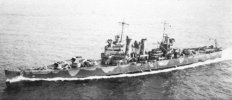
Port view in 1942
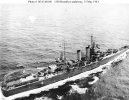
Underway at sea, 15 May 1943.

CL O'Hìggins (ex USS Brooklyn CL 40) in service 40 years in the Chilean Navy, from June 30, 1951, until September 27, 1991) Underway, half Dress-Ship, date and location unknown.
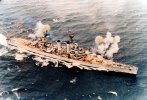
CL O'Hìggins (ex USS Brooklyn CL 40) in service 40 years in the Chilean Navy, from June 30, 1951, until September 27, 1991) firing a broadside off the port side, date and location unknown.
USS Brooklyn served primarily in the Atlantic and Mediterranean during WW2, and was transferred to Chile where she continued to serve until her decommissioning in 1992.

Port view in 1942

Underway at sea, 15 May 1943.

CL O'Hìggins (ex USS Brooklyn CL 40) in service 40 years in the Chilean Navy, from June 30, 1951, until September 27, 1991) Underway, half Dress-Ship, date and location unknown.

CL O'Hìggins (ex USS Brooklyn CL 40) in service 40 years in the Chilean Navy, from June 30, 1951, until September 27, 1991) firing a broadside off the port side, date and location unknown.
No matter the ship or size guns, always a great thing to watch.firing a broadside
SM U-27 was the lead boat of 4 German U-27 submarines in WW1. She was the first submarine to sink another submarine when in October 1914 she sank HMS E3.
U-27 was sunk in August 1915 by the Q-ship HMS Baralong. The British sailors were under orders to take no survivors from U-boats and shot 12 German sailors swimming away from their submarine.

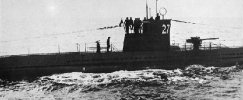
U-27 was sunk in August 1915 by the Q-ship HMS Baralong. The British sailors were under orders to take no survivors from U-boats and shot 12 German sailors swimming away from their submarine.


Today is the 50th anniversary of the sinking of the SS Edmund Fitzgerald. At the time of her launching in 1958, she was the biggest ship on the Great Lakes. (729 ft long with a beam of 75 ft). Lost with all hands on 10 November 1975.

 en.wikipedia.org
en.wikipedia.org
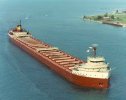

SS Edmund Fitzgerald - Wikipedia

skybert
Skybert
I remember being in the car with my mom and hearing about a ship missing on the radio….Today is the 50th anniversary of the sinking of the SS Edmund Fitzgerald. At the time of her launching in 1958, she was the biggest ship on the Great Lakes. (729 ft long with a beam of 75 ft). Lost with all hands on 10 November 1975.

SS Edmund Fitzgerald - Wikipedia
en.wikipedia.org
View attachment 43871
The Squadron of Evolution
By 1881, the once mighty US Navy that carried the nation through the Civil War had withered from a fleet of 600 ships in the 1860s to one that was barely fit to be called a navy. There were good reasons, westward expansion and the rapid rate of industrial development pulled attention from the armed forces, and the nation still carried memories of the war. The deterioration was to such an extent that the US Pacific Squadron was threatened by Chile if it interfered with their war with Peru. Within the fleet, aging admirals wedded to their greatest days gone by clung to obsolete wooden ships, coastal monitors and riverine gunboats that would no longer serve the vital needs of the country. Gradually, industrial and commercial interests, and the US Congress, began to think of the broader aspects of US maritime presence and of a navy to support and to protect such a presence - driving them was the recently published book “The Influence of Sea Power upon History, 1660–1783,” by Alfred Mahan.
Memoranda and reports were circulated among the various committees in Congress and the Department of the Navy promoting a fleet of ships, and a corps of officers, not consumed with sail power nor hampered by tradition. From this activity, the administration of President Chester A. Arthur established the Office of Naval Intelligence in 1882, signed the Naval Act of 1883 and opened the Naval War College in 1884. Cheering from the sidelines was the future Secretary of the Navy and President, Theodore Roosevelt.
The act of 1883 authorized four steel hulled ships - three protected cruisers and a dispatch vessel. Soon, three smaller vessels, all of the same class, were added to the other ships. The protected cruisers were commissioned in 1886, 1887 and 1889 and were all of separate design. The three "gunboats" of the Yorktown-class were based on a Royal Navy cruiser design, the HMS Archer-class of eight ships. These three were commissioned in 1889 and 1891. One other actual gunboat and five unprotected cruisers were in commission from 1890 to 91. All were designed to “teach” the U.S. Navy how to operate and maintain steel ships while simultaneously giving it a global reach.
Among the lessons learned was a need for permanent bases for coaling which gave us Pearl Harbor, Midway, Wake, and eventually Guam and the Philippines. Although the fleet never fired a shot in battle, it was a pivotal moment in American naval development.
The cruisers were;
USS Atlanta, 1886
USS Boston, 1887
USS Chicago, 1889
The Yorktown-class were;
USS Yorktown, 1889
USS Bennington, 1891
USS Concord, 1891
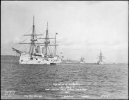
By 1881, the once mighty US Navy that carried the nation through the Civil War had withered from a fleet of 600 ships in the 1860s to one that was barely fit to be called a navy. There were good reasons, westward expansion and the rapid rate of industrial development pulled attention from the armed forces, and the nation still carried memories of the war. The deterioration was to such an extent that the US Pacific Squadron was threatened by Chile if it interfered with their war with Peru. Within the fleet, aging admirals wedded to their greatest days gone by clung to obsolete wooden ships, coastal monitors and riverine gunboats that would no longer serve the vital needs of the country. Gradually, industrial and commercial interests, and the US Congress, began to think of the broader aspects of US maritime presence and of a navy to support and to protect such a presence - driving them was the recently published book “The Influence of Sea Power upon History, 1660–1783,” by Alfred Mahan.
Memoranda and reports were circulated among the various committees in Congress and the Department of the Navy promoting a fleet of ships, and a corps of officers, not consumed with sail power nor hampered by tradition. From this activity, the administration of President Chester A. Arthur established the Office of Naval Intelligence in 1882, signed the Naval Act of 1883 and opened the Naval War College in 1884. Cheering from the sidelines was the future Secretary of the Navy and President, Theodore Roosevelt.
The act of 1883 authorized four steel hulled ships - three protected cruisers and a dispatch vessel. Soon, three smaller vessels, all of the same class, were added to the other ships. The protected cruisers were commissioned in 1886, 1887 and 1889 and were all of separate design. The three "gunboats" of the Yorktown-class were based on a Royal Navy cruiser design, the HMS Archer-class of eight ships. These three were commissioned in 1889 and 1891. One other actual gunboat and five unprotected cruisers were in commission from 1890 to 91. All were designed to “teach” the U.S. Navy how to operate and maintain steel ships while simultaneously giving it a global reach.
Among the lessons learned was a need for permanent bases for coaling which gave us Pearl Harbor, Midway, Wake, and eventually Guam and the Philippines. Although the fleet never fired a shot in battle, it was a pivotal moment in American naval development.
The cruisers were;
USS Atlanta, 1886
USS Boston, 1887
USS Chicago, 1889
The Yorktown-class were;
USS Yorktown, 1889
USS Bennington, 1891
USS Concord, 1891

AIRMMCPORET
Plan “A/B” Retired
Today is the 50th anniversary of the sinking of the SS Edmund Fitzgerald. At the time of her launching in 1958, she was the biggest ship on the Great Lakes. (729 ft long with a beam of 75 ft). Lost with all hands on 10 November 1975.

SS Edmund Fitzgerald - Wikipedia
en.wikipedia.org
View attachment 43871
This evolution continued with the next evolutionary leap near the end of the 19th century,The Squadron of Evolution
C-6 USS Olympia
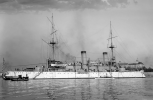

USS Olympia - War History
USS Olympia (C-6/CA-15/CL-15/IX-40) is a protected cruiser that saw service in the United States Navy from her commissioning in 1895 until 1922. This vessel...

